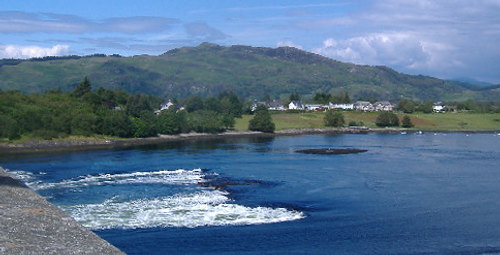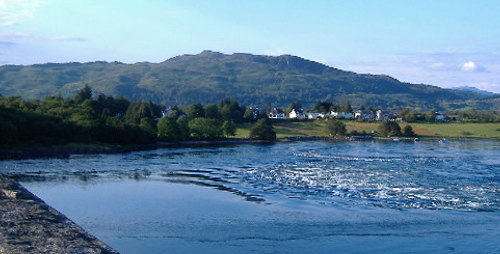The middle waves in a flood tide
The middle waves
This feature of the flood tide is where the incoming tidal flow meets the reef, and produces a ramp, and a series of green waves. They are nothing like the waves on the ebb tide, they are far too flat for playboats, but are suitable for sea kayaks - again they can sometimes produce excellent surfing. However they do have their downsides.
The first of these is the very confused water behind them - a complex mixture of breaking waves, haystacks, whirlies and boils makes for quite challenging conditions - very different from big seas. I have capsized in it - I was pushed round by a whirlie so I was broadside on, and an unfriendly wave decided to play with me. Fortunately it was on my good side, and I rolled back up.
Another downside is that - usually - most of the waves aren`t static, only the first one stays in place. All the others change shape dynamically, so just as you think you have picked up a wave, it collapses under you, and you are washed a bit further back to the next one.
Just occasionally, you get some excellent static waves - the best ones I have met so far was during the Springs during the high pressure that sat over the UK for a couple of weeks in late March 2012. On one of the days I had the best part of 10 minutes continuous surfing - the first part on the first wave, eventually I got washed off, but picked up the second wave for another five minutes or so. It was magic !
The third downside is that, as far as I know, the only way to get to the waves is to ferry glide out from the north pier, and drop backwards down onto the waves.
Once you have been washed through the waves, the only way to get back for another shot is to head north across all the rough water, round the east end of the sea-weed covered island (if it is still there), up the eddy, and back up to the north pier, to start all over again.
So it is a fair trek and hard work to get another shot at the waves. It would be easier if there was a way of getting back to the south pier, as then it would be a much shorter ferry glide. However at the moment I can`t see any way of getting back to the south pier from below the waves, there are some very strong currents in that area.
Something to be aware of is the fact that although the waves are across the falls, the water is actually flowing through the waves somewhat diagonally. To stay on the waves, you need to be surfing pointing diagonally - mostly by pointing to the north, but if you go too far over, the direction of flow changes, and it will turn you round to the right and off the wave. It is very easy to drift to the left without noticing, and you loose the wave.
Personally, I love the experience of the ferry glide out, and droping backwards down onto the waves. And of course the surfing ! But the confused water over the reef is not fun, and being a bit of a wimp, I usually wait until it has died down a bit before venturing out.
What causes the waves ?
For quite a long time I assumed that the waves are caused by the water flow dropping over the reef - it wasn`t until I stayed locally and was crossing the bridge quite often, that I realised that the waves form at the front of the reef. Here are two photographs taken a few hours apart from the same place on the bridge - you can see the position of the reef at low tide, and the position of the waves at high tide. Low tide height was about 0.8 metres, and high tide height was around 3.9 metres.


I haven`t worked out quite why the waves form, a possible explanation can be gained from the shape of the water flow - because of the obstruction caused by the reef, the incoming water flow splits into two under the bridge, and so forms a quite distinct Y-shape - the stem of the Y is to the west of the bridge, the middle of the Y is under the bridge, and the two arms of the Y flow round the two ends of the reef. The area between the two arms is a high pressure area because of the obstruction caused by the reef, and once the water meets the reef, the pressure drops, and the waves form. The existence of the high pressure area can be seen by a distinct raised area, and the ramp leading down to the waves indicates the drop in pressure. However this all a big guess - it is curious in that in a river, you expect to see the waves after the obstruction, not over the top of it.
Quite apart from the waves, the flood tide produces another interesting effect - for about a kilometre east of the bridge, the water flow isn`t just straightforward, it is continually changing shape - with chutes of fast water, eddies in the middle of nowhere, and whirlpools. You paddle along, then without any warning, you find yourself sitting in an eddy paddling forward and going backwards, and just a few metres to your side, there is a fast stream going in the direction you want to go in. The whirlpools are quite benign, but can be quite strong, and you start spinning round. There is not much point in fighting it, the whirlpool will win, you might as well sit there and enjoy it - it could be your only chance of ever doing a 360 in a sea kayak !
Or maybe not - read on !